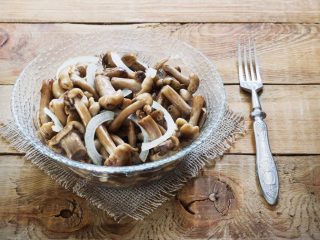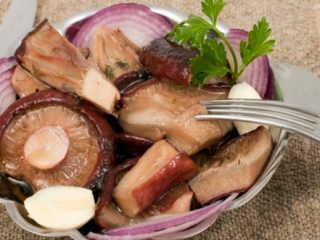Content
Camelinas occupy a leading position in nutritional value of all tubular species. The composition of the protein in the fruit body is not inferior to protein of animal origin. The mushroom is popular not only because of its taste, but also for its versatility in processing. Fermented, salted or pickled saffron milk caps do not lose their beneficial properties and retain their shape, bright color and characteristic taste and aroma well.
Secrets of making pickled saffron milk caps
Only young specimens are taken for harvesting for the winter. In overripe fruiting bodies, the protein begins to disintegrate, releasing toxic compounds. Damaged ones are also not used. No matter how carefully the mushrooms are processed, larval waste remains in the pulp, significantly reducing the value of the processed product. To prepare pickled saffron milk caps, select specimens whose caps do not exceed 5 cm. They are collected in an environmentally friendly area.
Glass jars of any convenient size, enamel dishes or wooden barrels are used for preparations. Ryzhiki, fermented in an oak barrel, have a pleasant tart woody smell. Pickled mushrooms become more elastic.
Before laying the fruiting bodies, the wooden container is filled with warm water for 1-2 days.The material will be saturated with moisture and increase in size, which will prevent the barrel from leaking in the future. Before storing, any type of container is washed with a weak solution of baking soda and treated with boiling water.
Pickled saffron milk caps turn out tasty if the temperature is maintained. The recipe calls for the use of sourdough. The optimal temperature for fermentation is 15-20 0C, in such an environment, lactic acid bacteria multiply well, and the process proceeds normally.
Recipes for making pickled saffron milk caps for the winter
For any workpiece, raw materials are pre-prepared:
- The fruiting bodies are cleared of soil and remnants of grass or leaves.
- At the base, the fruit leg is cut off by about 1.5-2 cm.
- Remove the film from the cap; you can leave it on young specimens.
- The fruiting bodies are washed.
- To allow the remaining sand to settle to the bottom, the mushrooms are soaked for 40 minutes.
- Pour boiling water over it and let the water drain.
- Separate the caps from the legs. This is done during the pickling process, because the mushrooms secrete milky juice, which quickly oxidizes and turns dark green.
In some recipes, saffron milk caps are boiled. This point is not important; boiling does not affect the taste of pickled mushrooms and will not shorten the fermentation time.
A simple recipe for pickled saffron milk caps
One of the fastest methods of processing with minimal material costs. The recipe is designed for 10 kg of raw materials; for smaller or larger volumes, the ingredients are changed in accordance with the proportions:
- salt – 350 g;
- sugar – 4 tbsp. l.;
- whey – 0.5 l.
Spices are added as desired, you can use green dill or seeds, garlic. The recipe does not include a bay leaf; it does not combine with fermented milk products; pickled saffron milk caps will acquire an unpleasant odor.
Sequence of work:
- The raw materials are placed in the prepared container in layers.
- Sprinkle each layer with salt.
- Combine sugar and fermented milk product, stir until the crystals dissolve.
- Pour into the preparation.
- A weight is placed on top.
Remove mushrooms for fermentation. After a day, the process is checked, the saffron milk caps should release juice.
Foam areas form on the surface, and a sour smell emanates from the workpiece. This means that fermentation has begun, and in 20 days the mushrooms will reach the desired condition.
Pickled saffron milk caps with horseradish root
Mushrooms prepared according to the recipe with horseradish are quite popular. Pickled saffron milk caps are not only a favorite home dish, they are included in the menu of many elite restaurants and are in high demand. To prepare you will need:
- mushrooms – 10 kg;
- any fermented milk product – 0.5 l;
- medium-sized horseradish root – 2 pcs.;
- dill seeds – 200 g;
- salt – 350 g;
- garlic – 2-3 heads;
- black currant leaves – 25 pcs.;
- sugar – 150 g.
Preparing pickled mushrooms:
- Currant leaves are placed in a colander and poured over with boiling water.
- Peel the horseradish root and pass it through a meat grinder. Horseradish juice causes irritation to the mucous membranes of the eyes and respiratory organs, so work is carried out in a well-ventilated area.
- Garlic is cut into thin slices.
- Place the saffron milk caps in a container in layers, sprinkle each layer with salt and spices, and place currant leaves on top.
- Sugar is dissolved in whey or kefir and added to the preparation.
- A weight is placed on top of the mushrooms.
After a few days, check the level of water release from the mushrooms. If there is not enough liquid, add boiled salted water so that the surface is completely covered. If there are no deviations from the proportions of the recipe, the saffron milk caps, under the weight of oppression, produce a sufficient amount of juice.
Pickled saffron milk caps with cabbage
A tasty, low-calorie dish - pickled saffron milk caps together with cabbage are recommended for obese people. The preparation is useful for digestion, contains a large amount of vitamins and microelements, the deficiency of which is especially noticeable in winter. Required components:
- mushrooms – 600 g;
- shredded cabbage – 2 kg;
- water – 0.5 l;
- dill (seeds) – 4 tsp;
- salt – 2 tbsp. l.;
- sugar – 1 tbsp. l.;
- black pepper (peas) – 30 pcs.;
- medium sized carrots – 2 pcs.
Preparing pickled saffron milk caps with cabbage:
- The cabbage is chopped.
- Carrots are grated or cut into small squares.
- Ryzhiki are combined with vegetables.
- Add spices and mix the mixture.
- Dissolve sugar and salt in warm water.
- The workpiece is placed in a container and compacted.
- They pour out the water.
After a day, the fermentation process will be noticeable from the foam on the surface, so that the air can escape, the workpiece is pierced in several places. The readiness of pickled saffron milk caps and cabbage is determined by the color of the brine; when it becomes transparent, it means the processing process is complete.
Terms of storage conditions
Containers with pickled saffron milk caps are lowered into the basement or placed in a room where the temperature does not exceed +50 °C. At a higher rate, the fermentation process will resume and the product will deteriorate. Make sure that the fruiting bodies are in liquid; if necessary, add boiled salted water. If mold is found, it is removed, the mugs are washed and pressed with saline solution.If the storage technology is followed, pickled mushrooms will be suitable until the next season.
Conclusion
Pickled saffron milk caps are a low-calorie, tasty product. For winter preparations, you can use a traditional simple recipe that requires minimal skills and material costs. Pickled saffron milk caps with horseradish or cabbage are especially popular.











